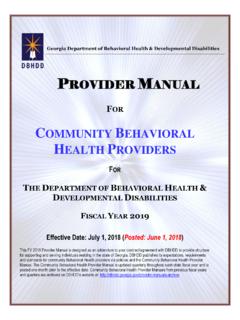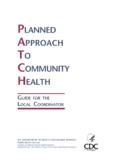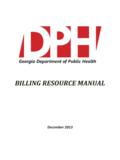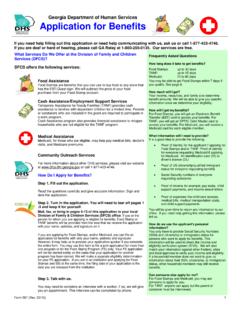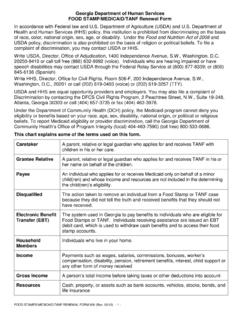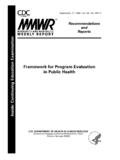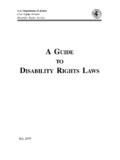Transcription of GUIDELINES COMMUNITY NOISE - WHO
1 GUIDELINESFORCOMMUNITY NOISEE dited byBirgitta BerglundThomas LindvallDietrich H SchwelaThis WHO document on the GUIDELINES for COMMUNITY NOISE is the outcome of the WHO- expert taskforce meeting held in London, United Kingdom, in April 1999. It bases on the document entitled COMMUNITY NOISE that was prepared for the World Health Organization and published in 1995 by theStockholm University and Karolinska Health Organization, GenevaCluster of Sustainable Development and Healthy Environment (SDE)Department of the Protection of the Human Environment (PHE)Occupational and Environmental Health (OEH)
2 ITABLE OF sources and their Aspects of Acoustical of Complexity of NOISE and Its Practical Characteristics and Sound transmission Into and Within Specialized NOISE Health Effects Of Hearing with Speech and Physiological Health Effects of NOISE on of NOISE on Residential Behaviour and Effects of Combined NOISE Guideline in NOISE Exposure Exposure Control of Control of Indoor Setting in NOISE on NOISE And of the WHO Work on 1 : Bibliographical 2 : Examples Of Regional NOISE 3 : 4 : 5 : Equations and other technical 6 : Participant list of THE WHO Expert Task Force meeting on GUIDELINES ForCommunity NOISE , 26-30 April 1999, MARC, London, has always been an important environmental problem for man.
3 In ancient Rome, rules existed as tothe NOISE emitted from the ironed wheels of wagons which battered the stones on the pavement, causingdisruption of sleep and annoyance to the Romans. In Medieval Europe, horse carriages and horse backriding were not allowed during night time in certain cities to ensure a peaceful sleep for the , the NOISE problems of the past are incomparable with those of modern society. An immensenumber of cars regularly cross our cities and the countryside. There are heavily laden lorries with dieselengines, badly silenced both for engine and exhaust NOISE , in cities and on highways day and and trains add to the environmental NOISE scenario.
4 In industry, machinery emits high NOISE levelsand amusement centres and pleasure vehicles distract leisure time comparison to other pollutants, the control of environmental NOISE has been hampered by insufficientknowledge of its effects on humans and of dose-response relationships as well as a lack of definedcriteria. While it has been suggested that NOISE pollution is primarily a luxury problem for developedcountries, one cannot ignore that the exposure is often higher in developing countries, due to bad planningand poor construction of buildings. The effects of the NOISE are just as widespread and the long termconsequences for health are the same.
5 In this perspective, practical action to limit and control theexposure to environmental NOISE are essential. Such action must be based upon proper scientificevaluation of available data on effects, and particularly dose-response relationships. The basis for this istheprocess of risk assessment and risk extent of the NOISE problem is large. In the European Union countries about 40 % of the populationare exposed to road traffic NOISE with an equivalent sound pressure level exceeding 55 dB(A) daytime and20 % are exposed to levels exceeding 65 dB(A). Taking all exposure to transportation NOISE togetherabout half of the European Union citizens are estimated to live in zones which do not ensure acousticalcomfort to residents.
6 More than 30 % are exposed at night to equivalent sound pressure levels exceeding55 dB(A) which are disturbing to sleep. The NOISE pollution problem is also severe in cities of developingcountries and caused mainly by traffic. Data collected alongside densely travelled roads were found tohave equivalent sound pressure levels for 24 hours of 75 to 80 dB(A).The scope of WHO s effort to derive GUIDELINES for COMMUNITY NOISE is to consolidate actualscientific knowledge on the health impacts of COMMUNITY NOISE and to provide guidance toenvironmental health authorities and professional trying to protect people from the harmfuleffects of NOISE in non-industrial environments.
7 Guidance on the health effects of NOISE exposureof the population has already been given in an early publication of the series of EnvironmentalHealth Criteria. The health risk to humans from exposure to environmental NOISE was evaluatedand GUIDELINES values derived. The issue of NOISE control and health protection was a WHO/EURO Task Force Meeting in D sseldorf, Germany, in 1992, the health criteria andguideline values were revised and it was agreed upon updated GUIDELINES in consensus. Theessentials of the deliberations of the Task Force were published by Stockholm University andKarolinska Institute in 1995.
8 In a recent Expert Task Force Meeting convened in April 1999 inLondon, United Kingdom, the GUIDELINES for COMMUNITY NOISE were extended to provide globalcoverage and applicability, and the issues of NOISE assessment and control were addressed inmore detail. This document is the outcome of the consensus deliberations of the WHO ExpertTask Richard HelmerDirector, Department of Protection of the Human EnvironmentCluster Sustainable Development and Healthy EnvironmentsvPrefaceCommunity NOISE (also called environmental NOISE , residential NOISE or domestic NOISE ) is defined asnoise emitted from all sources except NOISE at the industrial workplace.
9 Main sources of COMMUNITY noiseinclude road, rail and air traffic, industries, construction and public work, and the neighbourhood. Themain indoor sources of NOISE are ventilation systems, office machines, home appliances and neighbours. Typical neighbourhood NOISE comes from premises and installations related to the catering trade(restaurant, cafeterias, discotheques, etc.); from live or recorded music; sport events including motorsports; playgrounds; car parks; and domestic animals such as barking dogs. Many countries haveregulated COMMUNITY NOISE from road and rail traffic, construction machines and industrial plants byapplying emission standards, and by regulating the acoustical properties of buildings.
10 In contrast, fewcountries have regulations on COMMUNITY NOISE from the neighbourhood, probably due to the lack ofmethods to define and measure it, and to the difficulty of controlling it. In large cities throughout theworld, the general population is increasingly exposed to COMMUNITY due to the sources mentioned aboveand the health effects of these exposures are considered to be a more and more important public healthproblem. Specific effects to be considered when setting COMMUNITY NOISE GUIDELINES include: interferencewith communication; NOISE -induced hearing loss; sleep disturbance effects; cardiovascular and psycho-physiological effects; performance reduction effects; annoyance responses; and effects on 1980, the World Health Organization (WHO) has addressed the problem of communitynoise.










